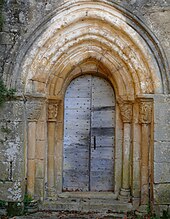Fajoles
|
Fajoles Fajòlas |
||
|---|---|---|
|
|
||
| region | Occitania | |
| Department | Lot | |
| Arrondissement | Gourdon | |
| Canton | Souillac | |
| Community association | Quercy-Bouriane | |
| Coordinates | 44 ° 48 ' N , 1 ° 24' E | |
| height | 118-213 m | |
| surface | 8.98 km 2 | |
| Residents | 288 (January 1, 2017) | |
| Population density | 32 inhabitants / km 2 | |
| Post Code | 46300 | |
| INSEE code | 46098 | |
 Church Notre-Dame-de-l'Assomption |
||
Fajoles ( Occitan : Fajòlas ) is a southern French town and municipality ( commune ) with 288 inhabitants (as of January 1, 2017) in the Lot department in the north of the Occitania region .
location
The place Fajoles is located about two kilometers from the north bank of the Lot River at an altitude of about 175 meters above sea level. d. M. in the old cultural landscape of the Quercy about 56 kilometers (driving distance) north of Cahors . The medieval pilgrimage town of Rocamadour is about 30 kilometers to the east; the formerly important town of Souillac with its extraordinary abbey church is located about 17 kilometers to the northeast.
Population development
| year | 1962 | 1968 | 1975 | 1982 | 1990 | 1999 | 2006 | 2012 |
| Residents | 255 | 262 | 253 | 243 | 220 | 211 | 270 | 262 |
In the 19th century the place had mostly between 550 and 680 inhabitants. As a result of the phylloxera crisis in viticulture and the mechanization of agriculture , the number of inhabitants has since declined continuously to the lows in the 1980s and 1990s.
economy
In the Quercy, agriculture, which included viticulture until the 19th century, was primarily self-sufficient for centuries . After the phylloxera crisis in the second half of the 19th century, viticulture in the region was temporarily completely abandoned, but red, rosé and white wines are now being produced again, which are marketed through the Comté Tolosan and Côtes du Lot appellations. Tourism in the form of renting holiday apartments ( gîtes ) is also important for economic life.
history
According to researchers, Neanderthals and Cro- Magnons lived together for long periods of time in a cave in the municipality . A large number of ancient Roman pottery shards were found elsewhere . A Romanesque parish church was built in the High Middle Ages .
Attractions
The parish church of Notre-Dame-de-l'Assomption is a compact but representative single-nave building from the 12th century in the shape of a Latin cross. The transverse rectangular and almost windowless crossing tower also towers above the transept ; Different stone material as well as wall joints or cracks indicate a later expansion of a square crossing tower to a defense tower and place of retreat for the village population. The apse , made of precisely hewn stones , is stabilized and structured by buttresses ; A console frieze runs beneath their eaves , above which a circumferential serrated frieze appears. The church has two Romanesque portals - one late Romanesque with Gothic-tapered archivolt arches and extremely 'primitive' Romanesque capitals on the south arm of the transept and another in the south wall of the nave , which protrudes about 25 centimeters from the wall; the former west portal was largely walled up. Church construction has been recognized as a monument historique since 1978 .
Web links
- Fajoles, wine information (French)
- Fajoles, church - photos + info (French)
- Fajoles, church - photos + info (French)
Individual evidence
- ↑ Église Notre-Dame-de-l'Assomption, Fajoles in the Base Mérimée of the French Ministry of Culture (French)

